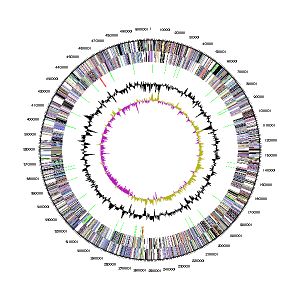Candidatus Accumulibacter Phosphatis
PAGE UNDER CONSTRUCTION
Classification
Kingdom: Bacteria
Phylum: Proteobacteria
Class: Betaproteobacteria
Order: unclassified Betaproteobacteria
Family: Candidatus Accumulibacter
Species
Candidatus Accumulibacter phosphatis
NCBI Taxonomy ID: 522306
Sub Groups:
Description and Significance
Describe the appearance, habitat, etc. of the organism, and why you think it is important. "Candidatus Accumulibacter phosphatis" is of the group of organisms know as polyphosphate-accumulating organisms (PAO).
This organism is a key species used in waste water treatment for the purpose of enhanced biological phosphorus removal (EBPR)(Lu). Waste water effluent can be a major contributor of phosphorous pollution to the environment, which can cause excess nutrient loading that leads to algal blooms. Traditional methods of Phosphorous removal include chemical remobal process and EBPR. Advantages of operating a waste water treatment plant with EBPR are that it significantly lowers operating costs, reduces sludge production and enables sludege to be reused easier, and eliminates chemical biproducts (Blackall, 2002). "Candidatus accumulibacter phosphatis" has been found in 4-18% of plants treating domestic sewage (Fukushima, 2007).
Genome Structure
Describe the size and content of the genome. How many chromosomes? Circular or linear? Other interesting features? What is known about its sequence?
The "Accumulibacter" Genome consists of one circular chromosome and three plasmids.
The size of this genome is 5306133 base pairs, coding for 4790 genes. 3.82% of the "Accumulibacter phosphatis" genome is unlike all other organisms in relation to both sequence similarity and function.
The Candidatus Accumulibacter phosphatis clade IIA str. UW-1; was mapped by the Department of Energy Joint Genome Institute (DOE JGI) in 2004 with an isolate collected from an EBPR wastewater treatment bioreactor in Madison, WI.
NCBI Mapped Genome Online genome information
Oligonucleotide probes which can help detect DNA and RNA sequences specific to “accumulibacter phosphatis” have been developed. This has allowed for studies of “accumulibacter” using florescent in situ hybridization and polymerase chain reactions (PCR) (Blackall, 2002).
Cell Structure, Metabolism and Life Cycle
Interesting features of cell structure; how it gains energy; what important molecules it produces.
Cell Structure
"Accumulibacter phosphatis" is a gram negative, rod shaped organism
Metabolism
Acetate Oxcidizer "Accumulibacter" is a chemoheterotroph and can exist in both aerobic and anaerobic conditions. This organism has an interesting metabolism, adapted for survival in both aerobic and anaerobic environments. It cycles molecules for energy generation or storage depending on the environmental conditions present.
Aerobic Conditions
Anabolic Pathway: Under aerobic conditions "Accumulibacter" uptakes orthophosphate from the environment and transforms it to polyphosphate, an energy rich phosphate chain. Polyphosphates are stored until conditions change from aerobic to anaerobic. “Accumulibacter” also stores glycogen in a similar manner to polyphosphate (Zhou 2008).
Catabolic Pathway: Poly-“B”-hydroxyalkanoates (PHAs), stored during anaerobic conditions, are reduced to Volatile Fatty Acids (VFAs) to produce energy for growth.
Anaerobic Conditions
Anabolic Pathway: Under anaerobic conditions “Accumulibacter” uptakes VFAs and stores the carbon in the cell in PHAs.
Catabolic Pathway: Polyphosphate, stored during aerobic conditions, is reduced to orthophosphate for the purpose of energy generation. The orthophosphate is released into the environment (Pijuan 2003). Another pathway exists through the reduction of glycogen by glycolysis. This process produces ATP and reducing equivalents (NADH) (Blackall, 2002).
Ecology and Pathogenesis
Habitat; symbiosis; biogeochemical significance; contributions to environment. If relevant, how does this organism cause disease? Human, animal, plant hosts? Virulence factors, as well as patient symptoms.
Habitat
"Accumulibacter Phosphatis" inhabits sediment and sludge. It is seeded in industrail wastewater treatment bioreactors for the purpose of accumulating phosphorouess. The sludge layers that commonly contain “Accumulobacter” also have communities of “actinobacteria”, “gammaproteobacteria”, and other species of “betaproteobacteria” (Blackall, 2002).
Candidatus Accumulibacter Phosphatis is a type of polyphasphate accumulating organism (PAO). PAOs are able to accumulate large amounts of phosphorus in the anaerobic zones of waste water treatment sludge. Sludge that was formed with the help of PAOs measures 4-5% Phosphorous content by dry weight; this is in contrast to 1.5-2% Phosphorous content by dry weight in the absence of PAOs (Blackall, 2002).
References
Author
Page authored by Johanna Kinster and Kevin Koryto, students of Prof. Jay Lennon Prof. Jay Lennon at Michigan State University.

